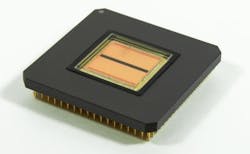| A 60-line sensor checks freshy minted bills for errors in their anticounterfeiting features. (Image copyright Fraunhofer IMS) |
Working with the Austrian Institute of Technology (AIT; Graz, Austria), a group at the Fraunhofer Institute for Microelectronic Circuits and Systems IMS (Duisburg, Germany) has created a high-speed 60-line line-scan image sensor useful for evaluating whether the anticounterfeiting features (such as holograms) on known-to-be-authentic banknotes are free of errors. The device works at a rate of 200,000 frames per second and has microsecond-scale exposure times.
The AIT's interest in the technology stems from the institute's interest in test systems for security printing. The new sensor, which is twice as fast as preceding sensors, scans bills as they come off the printing press.
The fact that the line-scan imager has 60 lines is important, as different pixel lines and columns can be used for different purposes. Each pixel column has an integrated readout chain and contains red, green, and blue detecting pixels, allowing the three colors to be detected over the entire pixel area. Different lines can be used to image objects from differing perspectives. "As a result, surface structures in 3D, such as the tilt effects of holograms, can also be checked for the first time," says Werner Brockherde, an IMS researcher.
To further exploit the multiple lines, other filters, such as UV or IR filters, can be placed on individual sensor lines -- wavelengths especially useful for identifying different types of plastics in recycling plants. The high-speed imager is also potentially useful for analyzing the rails beneath a train traveling at 300 km/h to see if the rails have hairline cracks.
The researchers say that, in a different configuration, the sensor could be used in a near-Earth satellite to take color scans of the Earth's surface to a 3 cm resolution.
The group aims to commercially unveil the device at the end of this year (2015).
(Posted on 3 June 2015)
